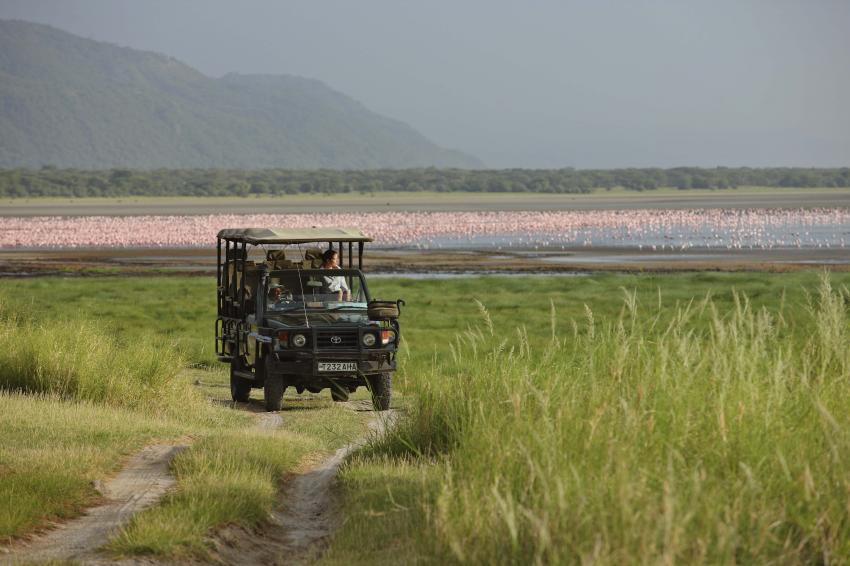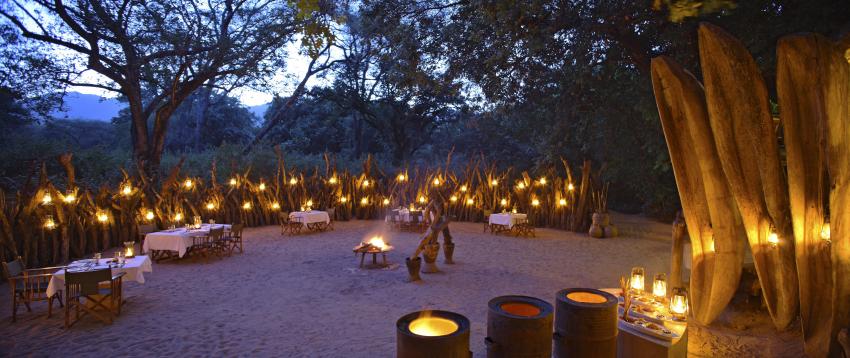One of Tanzania’s smallest and most underrated parks, Lake Manyara National Park sprawls between the Gregory Rift wall and the alkaline waters of Lake Manyara. It encompasses around 330 square kilometres of evergreen forest, savannah and marshlands, with its soda lake expanding to as much as 200 square kilometres during the wet season. It’s a hub for wildlife spotting and one of the most exciting bird watching destinations in East Africa….all without the crowds of visitors.

Lake Manyara National Park stretches for around 50 kilometres along the base of the 600-metre-high Rift Valley escarpment and its stunning landscapes were described by Ernest Hemingway as “the loveliest I had seen in Africa”. Despite its small size, Lake Manyara National Park boasts one of the highest biomass densities of large mammals in the world, with tree-climbing lions and large families of elephants a highlight. It’s also renowned for the thousands of flamingos that congregate along the lake’s edges during the wet season, transforming it into a haze of pink.
While most safari tourists visit Lake Manyara as a one-day trip from Arusha or along the Northern Circuit, this little-discovered gem deserves at least a couple of days. It’s an ideal destination for those who want to get off-the-beaten-track and escape the crowds, with a much quieter atmosphere when compared to the nearby Ngorongoro Crater. But if you’ve only got one day, its compact game-viewing is like a microcosm of the safari experiences available in Tanzania and not to be missed.
What animals can you see in Lake Manyara National Park?
Lake Manyara National Park is famed for the flamingos that inhabit its shores, with thousands flocking to the lake edges during the wet season. It’s also home to more than 400 recorded species of birds, many of which remain at this permanent water source throughout the year. On any given day, you can expect to see up to 100 different bird species, including large pelicans, cormorants and storks, making it one of Tanzania’s most fascinating destinations for twitchers.

In addition to its birdlife, the park’s grassy plains support Masai giraffe, wildebeest and zebra, as well as buffalo, gazelles and families of elephants that can be seen lumbering in large herds. Hippos can often be seen submerging and re-emerging themselves in the lake waters at one end of the park and it’s possible to exit your safari vehicle here and watch from a safe distance. Blue monkeys and baboons also inhabit the forests, with Lake Manyara National Park boasting one of the largest concentrations of baboons in the world.
Lake Manyara’s famous tree-climbing lions are another reason to visit, with this fascinating species unique to the park. Both lions and leopards are often spotted lounging in acacia trees in the north of the park when they’re not out hunting for prey. You should also keep your eyes peeled for groups of banded mongoose in the grasslands below, together with klipspringers and Kirk’s dik-dik. In the south of the park are bubbling hot springs that send plumes of steam into the air, adding yet another layer to this exciting natural destination.

Game drives are the main way of exploring Lake Manyara National Park, with a north-south road that can be covered in just a few hours. Most safari companies visit during the afternoon, so the morning is the best time to get out and about if you want to have the wildlife viewing experiences largely to yourself. The park also allows for night safaris if you want to encounter some of Lake Manyara’s nocturnal species, with a bush dinner under the stars an unforgettable way to complement this experience.
How to get to Lake Manyara National Park
Lake Manyara National Park is located 126 km (around 2.5 hours’ drive) southwest of Arusha, with domestic flights available to Arusha from the Julius Nyerere International Airport in Dar es Salaam and the Zanzibar International Airport. Alternatively, you fly into the Kilimanjaro International Airport and make the 50-kilometre drive to Arusha to begin your safari. While the road is paved all the way between Arusha and Lake Manyara National Park, some people prefer to fly directly to the Lake Manyara Airport, which is located at the top of the rift wall.
Many travellers opt to visit Lake Manyara National Park on a multi-day safari adventure that includes the Serengeti National Park and the Ngorongoro Crater along what’s known as the Northern Circuit. You can either drive the circuit to and from Arusha or opt to fly one way to the Serengeti’s airstrip if you want to reduce your time on the road. Alternatively, you can combine Lake Manyara National Park with a visit to Tarangire National Park, with the two located almost adjacent to one another.
Best time to visit Lake Manyara National Park
The best time to visit Lake Manyara National Park is generally considered to be during the dry season from June to October. The limited vegetation makes wildlife easier to spot and high concentrations cluster around the park’s water sources where they can be seen refuelling. Clear, sunny skies make it ideal for being out on game drives, while the absence of rain means a reduction in mosquitoes during the evenings. However, you should bring plenty of warm clothes as the mornings and nights can get very cold. It’s also important to be aware that lodge and camp rates will usually be at their highest during this period.

As the rains set in around November, many of the animals begin their migration north to the grazing grounds of the Masai Steppe. But it’s an ideal time to visit Lake Manyara National Park if you want to experience its spectacular birdlife, with migratory birds flocking from both Europe and Asia. Afternoons are usually marked by short rain showers that shouldn’t put too much of a dampener on sightseeing but it’s important to keep in mind that you won’t be treated to the big game wildlife spectacle of the dry season.
Where to stay in Lake Manyara National Park
There are a variety of lodges and camps in Lake Manyara National Park where you can base yourself, ranging from basic campsites and budget lodges to those with all the bells and whistles. There’s a budget-style campsite with a swimming pool and restaurant, as well as a more established lodge with breathtaking views across the lake.
Opt for one of the properties that perch on the Great Rift Valley escarpment for some of the most enviable vistas, complete with infinity pools and expansive view decks. You can also find luxurious tented camps set in the middle of the wilderness, offering all the comforts of home while enjoying an authentic African bush experience.

You can also stay in one of the safari lodges or camps inside Tarangire National Park and visit Lake Manyara from there. Alternatively, head to the Karatu area on the edge of the Ngorongoro Crater, which offers a myriad of accommodation options.
Want to plan an off-the-beaten-track safari in Lake Manyara National Park? Check out our diverse range of luxury lodges and camps to inspire you.

 1-321-766-6821
1-321-766-6821 








